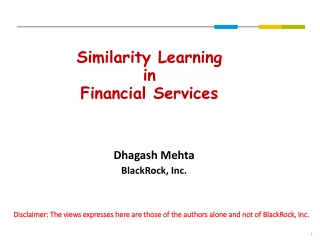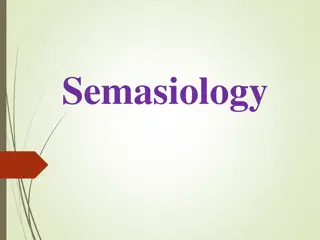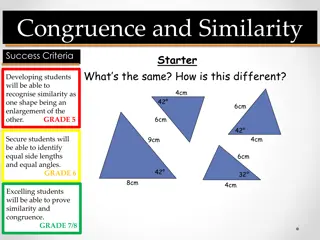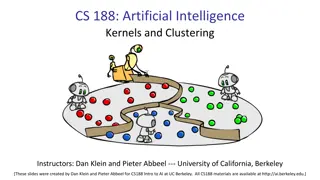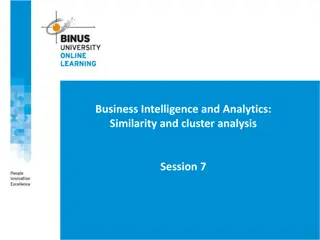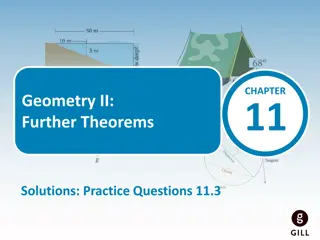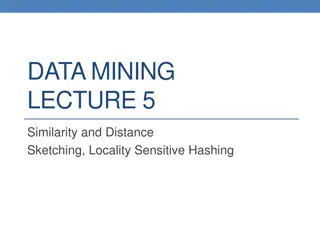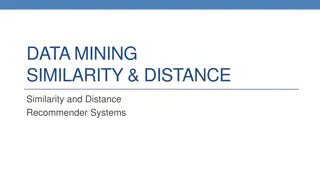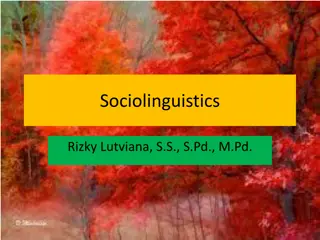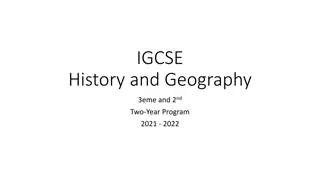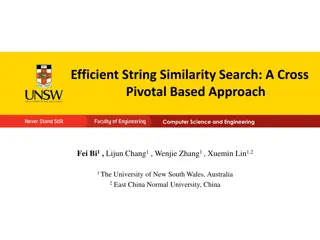Exploring the Two Dimensions of Meaning: Similarity and Contiguity in Language and Literature
This content delves into the dimensions of meaning, focusing on similarity and contiguity, as explored in language and literature. It discusses the significance of Saussure's paradigm and syntagm, Jakobson's theories on similarity and contiguity in discourse, and the impact of brain damage on language processing. The distinctions between metaphor and metonymy, as well as the correlation between brain regions and language impairments, are also highlighted.
Download Presentation

Please find below an Image/Link to download the presentation.
The content on the website is provided AS IS for your information and personal use only. It may not be sold, licensed, or shared on other websites without obtaining consent from the author.If you encounter any issues during the download, it is possible that the publisher has removed the file from their server.
You are allowed to download the files provided on this website for personal or commercial use, subject to the condition that they are used lawfully. All files are the property of their respective owners.
The content on the website is provided AS IS for your information and personal use only. It may not be sold, licensed, or shared on other websites without obtaining consent from the author.
E N D
Presentation Transcript
THE SIMILARITY DIMENSION OF MEANING: DANGERS TO ECOLOGY; ANTIDOTES IN LITERATURE Andrew Goatly, Honorary Professor, Lingnan University, Hong Kong (apgoatly@gmail.com)
OUTLINE OF LECTURE 2 dimensions of meaning: similarity and contiguity, metaphor and metonymy Nouns and Verbs/Clauses Language acquisition: from contiguity in action genres to academic abstraction Similarity, classification and mathematics Similarity, money and commodification Resisting over emphasis of similarity and the illusion of permanence in Literature Inevitability of the similarity dimension: metaphors for the earth. (Goatly 2022)
2 DIMENSIONS OF MEANING: SIMILARITY AND CONTIGUITY, METAPHOR AND METONYMY
Saussure: paradigm and syntagm The father of modern linguistics, Ferdinand de Saussure (1960), distinguished the paradigmatic axis and the syntagmatic axis of language. The paradigmatic axis: the choices we make in using language, e.g., which nouns to put in the blank in Amanda ate the ______. The syntagmatic axis: the way we combine these choices to make text. The choice is from the paradigms of words that are similar in word-class and semantics in the sentence above typically nouns referring to types of food The words combined in syntax will be next to each other or contiguous.
Brain damage, aphasia and Jakobsons theory: similarity and contiguity Jakobson used this distinction to highlight basic differences in ways of making meaning or discourse. The development of a discourse may take place along two different semantic lines: one topic may lead to another either through their similarity [paradigmatic] or through their contiguity [syntagmatic]. The metaphoric way would be the most appropriate term for the first case and the metonymic way for the second, since they find their most condensed expression in metaphor and metonymy respectively (1987: 10). [my insertions] Evidence for this distinction in research into two kinds of aphasia, language impairments arising from brain injury to Wernicke s area (in the temporal lobe): deficiencies in the paradigmatic selection axis, in similarity dimension (metaphor) Broca s area (in the posterior inferior frontal lobe): deficiencies in the syntagmatic combination axis, in contiguity dimension (metonymy)
Contiguity and Brocas area, Similarity and Wernicke s area
2 kinds of Aphasia Every form of aphasic disturbance consists in some impairment of the faculty either for selection and substitution or for combination and contexture. . The relation of similarity is suppressed in the former [Wernicke s area], the relation of contiguity in the latter type of aphasia [Broca s area]. Metaphor is alien to the similarity disorder, and metonymy to the contiguity disorder (Jakobson 1987: 9-10) [my addition in brackets]
Examples of deficiency/compensation Broca s aphasia patients: Spyglass for microscope or fire for gaslight compensate using the similarity dimension gaslight is a kind of fire Wernicke s aphasia patients: fork for knife and fork , table for table lamp , eat for toaster compensate using the contiguity dimension: text or action genre
Language, Meaning Processing And The Two Areas Ardila & Rosselli (1994), Damasio & Tranel (1993), Raichle (1994), Rizzolati & Arbib (1998), Ardila (2010) cf. Also The Master and his Emissary McGilchrist (2019) BROCA S AREA WERNICKE S AREA SYNTAGMATIC AXIS PARADIGMATIC AXIS CONTIGUITY SIMILARITY METONYMY METAPHOR VERBS + GRAMMAR NOUNS
What do we mean by similarity and contiguity? Similarity is the sharing of features. So, classifications, metaphors, superordinate-hyponym relations (e.g. bird penguin ) depend upon it. Contiguity means contextuality and, as well as co-text, context is often one of action genres. Literally it depends upon touching including relationships such as part to whole, place to object/event /person in that place. But also, by extension, time to object/person/event at that time, and cause and effect. Metonymy depends upon these relationships. Cause and effect relationships take us beyond local contiguities of action genres to consider global contiguities, e.g. chaos theory and butterfly flapping its wings.
Global Contiguity: Chaos Theory When a system is far from equilibrium, with stability at risk, then an event can have a causal effect producing another event apparently non- contiguous with it. The famous example is the idea that a butterfly flapping its wings in Brazil might cause a tornado in Texas, or, at least, help determine its course.
Similarity and contiguity in defining metaphor and metonymy A metaphor or metonymy occurs when a unit of text (the source term) is used with an unconventional meaning (the target). In metaphor this unconventional meaning is understood on the basis of similarity between source and target (Goatly 2011) In metonymy this unconventional meaning is understood on the basis of contiguity between source and target. (Goatly 2022) Metaphor e.g. The past is a foreign country. They do things differently there. (L. P Hartley (1973) The Go-between) Metonymy e.g. The doorways were screaming with laughter (Golding 1961 Free Fall: 20) The people in the doorways
Nouns and Verbs (cf. Langacker 1991) Entity status Object Energetic Interaction Word Class Noun Verb Instantiated In space In time Spatially compact Temporally compact Extension Temporally unbounded Autonomous (similarity) Wernicke s area Broca s area Spatially unbounded Dependent (contiguity) Autonomy/Dependence Processing
Verbs, process, contiguity, and contextualisation Lexical words Noun verb/adjective adverb preposition pronoun aux verb article Verbs less stable in meaning than nouns (fewer types, more tokens than nouns) Refer to processes that are impermanent Dependent (In English). More useful for contextualisation function in clauses with participants material process clauses reflect action genres and the contiguities of context Clauses designed for contextualisation, e.g. Grammatical/function words
Verbs/Clauses reflecting contiguity Time Circumstance Yesterday Actor Material process I fried Goal Place Circumstance the chicken on the new gas burner 1 3 4 2 Remember Broca s area associated with clause as well as verb processing: The material process verb establishes a relationship between participants, Actor and Goal, a syntagmatic contiguity reflecting the contiguities or context of a real action genre cooking. The Place Circumstance fills in another aspect of context. The Time Circumstance fills in another aspect of context. The tense also locates the action in a time prior to utterance. 1. 2. 3. 4.
Nouns, similarity, classification, abstraction and permanence Stable meaning for stable object. Independent More useful for classification Longer hyponymic chains: border collie -- collie dog mammal vertebrate animal (contrast verbs shorter hyponymic chains: march walk move ) Classification and similarity Sharing features: collies have all the defining features of dogs, dogs have all the defining features of mammals, etc. etc. Noun phrases designed for classification and sub- classification
Noun phrases reflecting similarity deictic those numerative two epithet black classifier diesel thing trains Exercise 1: Which elements of this noun phrase are primarily involved in classification and sub-classification
Noun phrases reflecting similarity deictic those numerative two 4 epithet black 3 classifier diesel 2 thing trains 1 Elements of noun phrase involved in classification and sub-classification 1. Common nouns assign things to a category or class 2. Classifiers sub-classify that class 3. Some epithets (objective) sub-classify the sub-class further Once classified they can be counted, 4.
Nouns and abstraction Because by classification they ignore individual properties, noun categories always involve abstraction. (contrast proper names) But this is much more pronounced when entirely abstract nouns, often nominalisations, are used in science and technology: e.g. growth, rate, magnitude, force, acceleration. e.g. Glass crack growth rate is associated with stress magnitude The abstract terms are nouns and can then be quantified or measured in mathematical terms or become part of abstract algebraic formula: e.g. F = ma (Force = mass multiplied by acceleration). Algebra is the most abstract of the branches of mathematics similarity taken to extremes. Also associated with abstract time e.g. rate, acceleration
Nouns and the illusion of permanence It is not possible in relativity to obtain a consistent definition of an extended rigid body, because this would imply signals faster than light. Actually, relativity implies that neither the point particles nor the quasi-rigid body can be taken as primary concepts. Rather these have to be expressed in terms of events and processes (Bohm 1980:123-124). The best image of process is perhaps that of the flowing stream whose substance is never the same. On this stream one may see an ever-changing pattern of vortices which evidently have no independent existence as such. Rather they are abstracted from the flowing movement, arising and vanishing in the total process of the flow (Bohm 1980: 48).
Process and spontaneous change Natural processes are not controllable as shown by thermodynamics and the theory of entropy unlike dynamic objects [i.e. in the Newtonian system of dynamics], thermodynamic objects can only be partially controlled. Occasionally they break loose into spontaneous change (Prigogine and Stengers 1985: 120). Spontaneity of natural systems has even been suggested as the force behind evolutionary change, the saltations, or jumps in the evolutionary record: When a system of simple chemicals reaches a certain level of complexity, it undergoes a dramatic transition, akin to the phase change ... when liquid water freezes. The molecules begin spontaneously combining to create larger molecules of increasing complexity Kauffman argued that this process of self-organisation led to life Much of the order displayed by biological systems results not from natural selection but from these pervasive order-generating effects. The whole point of it is that it s spontaneous order (Horgan 1998: 133).
LANGUAGE ACQUISITION: FROM CONTIGUITY IN ACTION GENRES TO ACADEMIC ABSTRACTION
Contiguity: language acquisition in context A child s earliest language is acquired during participation in action genres, for instance, eating in the high chair, going for a ride in the car, changing diapers, feeding ducks at the pond, building a block tower, taking a bath, putting away the toys, feeding the dog, going grocery shopping (Bruner 1983). The infant learns to participate in these action genres by understanding and sharing the purposes of the adult s actions. This involves realising what is the most relevant concept at any point in the action genre and therefore the focus of joint attention. If the adult utters a novel word or phrase, the relevant focus of attention narrows down the likely meaning. If the same word or phrase is used in other genre contexts, what is common to the different contexts will help to narrow the intended referents and messages even further (Tomasello 2008: 156-158). The commonality is where similarity becomes important
Contiguity: language acquisition in context ctd. Bruner (1983) -- children have, at base, not a grammar- learning agenda but a socio-interactional one. Language acquisition is achieved by a process of pattern detection in a communicative context rather than by mapping input onto innate grammatical concepts. Briefly, infants acquire language in action-genre contexts which highlight likely meanings, messages and referents. The structure of genres involves fundamental cognitive relationships expressed in a specific time period, such as cause and effect, agent and action, patient and action, place and action, all exploiting the contiguity dimension of meaning.
From Speech to Writing-- Exercise 2: verbs and nouns in speech How many nouns, excluding pronouns, can you identify in this conversation between a mother (MW) and her daughter s boyfriend (TB)? TB: Every one else has been talking about marriage but I m the one that s getting married. We will get married like you know, we intend to get married and that but not just yet MW: Don t get me wrong, I m not interfering //just want to know what TB: MW: you think about why you don t want to get married I mean you re both over eighteen, nothing I can do, but I don t like seeing Marion hurt TB: I don t want to get married just yet Oh no oh no
Speech to Writing, Contiguity to Similarity, Verbs to Nouns NOUNS IN RED. NOMINALISATIONS UNDERLINED GRAMMATICAL/FUNCTION WORDS IN BOLD. VERBS IN BLUE. A. TB: (1) Every one else (2) has (3) beentalking (4) about marriage (5) but (6) I m (7) the (8) one (9) that (10) s (11) gettingmarried. (12) We (13) will (14) getmarried (15) like (16) you know, (17) weintend (18) to (19) getmarried (20) and (21) that (22) but (23) not just yet MW: (24, 25) )Don tget (26) me wrong,(27,28) I m (29) notinterfering (30)I //just want (31) to know (32)what TB: Oh (33) no oh (34) no MW: (35) youthink (36) about (37) why (38) you (39,40) don twant (41) to (42) getmarried (43) I mean (44) you re (45) both (46) over eighteen, nothing (47) I (48) cando, (49) but (50) I (51,52) don tlike seeing Marion hurt TB: (53) I (54,55) don twant (56) to (57) getmarried just yet ---------------------------------------------------------------------------------------------------------------------------- B. (1)The great expansion (2) of (3) the use (4) of fertilisers (5) in (6) this century (7) has benefited mankind enormously, (8) but (9) the benefits are (10) not unalloyed. (11) The runoff (12) of chemical fertilisers (13) into rivers, lakes (14) and underground waters creates two important hazards. (15) Oneis (16) the chemical pollution (17) of drinking water. (18) In certain areas (19) in Illinois (20) and California (21) the nitrate content (22) of well water (23) hasrisen (24) to (26) a toxic level. Excessive nitrate (27) cancause (28) the physiological disorder methemoglobinemia, (29) whichreduces (30) the blood s oxygen carrying capacity (31) and (32) canbe particularly dangerous (33) to children (34) under five. FUNCTION WORDS (57 IN A, 34 IN B) OFTEN RELATING THE TEXT TO CONTEXT., E.G. DEICTICS, PERSONAL PRONOUNS ETC.
Acquisition of Written Genres: Contiguity and Abstraction Abstraction Genre Purposes Abstraction Specific Time Process oriented ? Human actor ? Factual order X DISCUSSION To present information and opinions about more than one side of an issue: it may end with a recommendation based on the evidence presented To advance or justify an argument or put forward a particular point of view To represent factual information about a class of things usually by first classifying them and then describing their characteristics, e.g. encyclopedia entry for an animal To represent factual information about a particular place, thing, person or situation, by giving their characteristics, e.g. witness description of a suspect To explain why things are as they are or how things work, e.g. encyclopedia entry for photosynthesis To show how something can be accomplished through a series or steps of actions to be taken, e.g. recipe To tell a story in order to make sense of events and happenings in the world To construct past experience by retelling events and incidents in the order in which they occurred, e.g. diary entry X ? ARGUMENT X X ? ? ? INFORMATION REPORT X X X X DESCRIPTION X X X EXPLANATION X X ? PROCEDURE X X ? NARRATIVE X? ? RECOUNT
Narrative and the contiguity dimension Narrative fiction, using Labov s model of narrative structure (Labov 1972), can be seen as an expansion and repetition of the textual contiguity found in the clause. Clause Narrative Circumstances of time and place and relational/stative clauses Orientation Material, verbal (mental) processes Complicating Action & Resolution Participants (actors, goals/patients, sayers, receivers, sensors/experiencers, phenomena/experiences) Characters Do the contiguities manifest in the clauses and expanded in literary narrative reflect local or global contiguities? The dangers of limiting ourselves to the local contiguities of a specific location and time, with specific individual participants, according to our immediate unaided perceptual experience.
Modern European novels: local contiguity and the betrayal of ecology Amitav Ghosh sThe Great Derangement: Climate Change and the Unthinkable (2016) laments the modern novel s restriction to local contiguities: Fiction makes possible the imagining of possibilities. And to imagine other forms of human existence is exactly the challenge that is posed by the climate crisis: .But this challenge has appeared before us at the very moment when the form of imagining that is best suited to answering it fiction has turned in a radically different direction. (Ghosh 2016: 128 129) Some problems in contemporary novels are: (1) limitation to specific places and times, i.e. local contiguities, excludes forces of unthinkable magnitude that create unbearably intimate connections over vast gaps in time and space (Ghosh 2016: 63). Contrast epics. The Odyssey ranges over wide spaces, The Ramayana and Chinese folk epic The Journey to the West, over eras and epochs. (2) separation from the natural world, the planet and its history entailed by progress through linear time (cf. Hegel and Marx). Concentrating on the avant-garde erases every archaic reminder of Man s kinship with the nonhuman (Ghosh 2016: 70). During a period of surging carbon emissions very few of the literary minds [...] were alive to the archaic voice of the earth and its atmosphere (Ghosh 2016: 124). (3) instead of the forces of nature or the social collective, a fixation on individual characters moral choices (Ghosh 2016: 77). Ironically, just as we realise global warming is in every sense a collective predicament, humanity finds itself in the thrall of a dominant culture in which the idea of the collective has been exiled from politics, economics, and literature alike (Ghosh 2016: 80 81). Conclusion -- the contemporary novel fails to: consider climate change, pollution and resource depletion; address ecological problems with collective action; imagine a different world that takes into account global and epochal natural forces beyond individual moral choice. Ecology is betrayed by emphasis on the local contiguities of individual experience.
Qualification of Ghosh MARCO CARACCIOLO (2021): NARRATING THE MESH The great expanse of time (longue dur e) the Great Bay by Dale Pendell Non-human entities as actors: Being Dead by Jim Crace; Galapagos by Kurt Vonnegut Metaphorical blurring of human-non-human boundaries: Vaster than empires and More Slow by Ursula Le Guin; As She Climbed across the Table by Jonathan Lethem. Addressing the climate crisis: Oryx and Crake by Margaret Atwood; The Stone Gods by Jeanette Winterson; Solar by Ian McEwan.
SIMILARITY, CLASSIFICATION AND MATHEMATICS
Similarity taken to extremes: mathematics Once classified, by the noun phrase, objects can be counted/measured (e.g. by numeratives). Qualitative differences are reduced to the quantification of mathematics. Theoretically, reduction of quality to quantity began with Pythagoras, who found that the note produced by a vibrating string (a quality) depended on the length of the string (quantity). So If the ultimate nature of things (quality) depends on mathematical relationships (quantity), then it follows that the world as perceived by our senses must be logical and intelligible as mathematics (Habgood 2002: 6-7) Mathematics has been the benchmark for science. Galileo: measure what can be measured, and make measurable what cannot be measured (Gaarder 1996: 203). Descartes had a vision of the Angel of Truth who told him that mathematics was the key to unlocking the secrets of nature (Lent 2017: 235). Aldous Huxley pointed out, the scientist selects from the whole of experience only those elements which can be weighed, measured, numbered, or which lend themselves in any other way to mathematical treatment (Peat 1996: 239).
Mathematics: similarity taken to extremes Ladder of academic disciplines investigating different kinds of reality: religious studies (theology) philosophy arts and humanities social sciences economics psychology biology chemistry physics mathematics Explaining one level in terms of another is distorting At each stage entirely new laws, concepts and generalisations are necessary Psychology is not applied biology, nor is biology applied chemistry (Anderson 1972: 393). And none of the disciplines above it is simply applied mathematics. From bottom to top: mathematics and God/ultimate truth: For Roger Bacon, an early Western scientist, maths allowed us to understand the mind of the creator. Kepler: What else can the human mind hold besides numbers and magnitudes? These alone we apprehend correctly, and our comprehension is the same kind as God's (Lent 2017: 344- 346). Newton believed by his mathematical laws of motion he was defining God's laws as revealed in the book of nature. Georg Cantor thought his mathematical study of infinity could prove the existence of God. (Lent 2017: 350-52).
Similarity taken to extremes: mathematics ctd. In 1998, at the White House, Stephen Hawking made the following prediction: We shall have to rely on mathematical beauty and consistency to find the ultimate Theory of Everything. Nevertheless, I am confident we will discover it by the end of the 21stcentury, and probably much sooner. (Gleick 2021: 36). Gleick sresponse: Why should the universe, which grows more gloriously complex the more we see, be reduced to one set of equations and formulae? Dangers for ecology. It is distorting to employ numerical models to measure nature, and ecological crises. Verification and validation of numerical models of natural systems is impossible since natural systems are always open, making our knowledge of them incomplete, or, at best, approximate, and factoring out the unknown and unmeasurable. These mathematical models might be thought of as a work of fiction (Oreskes, Belitz, & Frechette 1994, quoted in Horgan 1998: 202-203).
SIMILARITY AND COMMODIFICATION
Similarity taken to extremes: money/commodification Moving from counting to accounting. Equating objects with each other through their monetary value. e.g. 10 euros, establishes a most abstract category which includes all the goods in their various numbers and quantities that can be bought for 10 euros: 2 metres of X, 12 kilos of Y, or 50 Zs. These quantities of X, Y and Z belong to the same category because they share an identical value of 10 euros. or or = 10 euros Market economics maximize efficiency by commodification; as many objects as possible, belonging to noun-based quantifiable classes, are brought into the money-based system. Humans and nature become market commodities, and are exploited/destroyed for profit.
Commodification of humans and nature Humans: Think of blood bank, organ bank, sperm bank. Blood AIDS in rural China, haemophiliacs with AIDS/hepatitis in UK. Organs. Young men from Moldova and Romania were paid $2,500 for a kidney that would be transplanted into a patient who was paying between $100,000 and $200,000. Genes. In the US you can make bids of tens of thousands of dollars on the internet for the eggs and sperm produced by glamour models (Habgood 2002: 128). The human genome draft was completed in June 2000. By December there were already 9,364 applications for patents covering 126,672 genes and small sub- gene fragments, increasing at the rate of 34,500 every month. Nature Land. The idea of ownership of land was alien to native Americans and Africans before colonisation Water: privatisation in France and England Plants: neem tree; Monsanto s terminator technology
Dangers of commodification As Marx noted, money reduces the use values of the multidimensional ecosystem, human desires and needs, and subjective meanings to a common measurable objective standard which everyone can understand (Harvey 1996: 150-1). In the market place, for practical reasons, the innumerable qualitative distinctions which are of vital importance for man [sic] and society are suppressed; they are not allowed to surface. Thus the reign of quantity celebrates its greatest triumphs in The Market . Everything is equated with everything else. To equate things means to give them a price and make them exchangeable (Schumacher 1999: 30). The reductionism of money when allied with mathematically-based technology neglects bio-diversity pretending difference is unimportant, only monetary value.
RESISTING OVEREMPHASIS OF SIMILARITY AND THE ILLUSION OF PERMANENCE IN LITERATURE
Resistance to classification/similarity--individuation The medieval philosopher Duns Scotus Haeccitas thisness -- the features in a particular object that make it different from other members of its class. Haeccitas inhered in every created thing, inanimate, animal or human. It was the mark of its Creation by God, and it was active. So it was lived out in action and in movement: each thing veered towards a particular destiny or purpose. This process involved the will, the expression of individuality. (https://crossref-it.info/articles /187/Inscape-and-instress retrieved 20/12/2020). Building on Duns Scotus, Gerard Manley Hopkins developed the concepts of inscape and instress. Inscape is the uniqueness of all natural phenomena, whether leaf, fingerprint, or snowflake. Every individual, including humans, the most fully individuated, actively expresses its identity selves . Instress is the reciprocal interaction between selving and the human response to it, the reaching out in love to this uniqueness. As a priest, Hopkins believed that instress was a response to the divine, since the individuation of inscape derives from God as creator.
Gerard Manley Hopkins As Kingfishers Catch Fire As kingfishers catch fire, dragonflies draw flame; As tumbled over rim in roundy wells Stones ring; like each tucked string tells, each hung bell s Bow swung finds tongue to fling out broad its name; Each mortal thing does one thing and the same: Deals out that being indoors each one dwells; Selves goes itself; myself it speaks and spells, Crying Wh t I d is me: for that I came. I say m re: the just man justices; Keeps grace: th t keeps all his goings graces; Acts in God s eye what in God s eye he is Chr st for Christ plays in ten thousand places, Lovely in limbs, and lovely in eyes not his To the Father through the features of men s faces. (Hopkins 1967: 90) Noun senses inevitably reflect categories, but this poem stresses the each and points to the individual uniqueness of every member of the category. Each different plucked string, swung bell, indeed every mortal, impermanent, transitory thing expresses its individuated essence, selves its inscape, thereby fulfilling its divine purpose. Recognising Christ in these selving objects and in the ten thousand different faces or unique features of every human face is the instress response to the divine dynamic creativity.
Birdsong for Two voices Corncrakes https://www.youtube.com/watch?v=cPDOM6rPYN s&ab_channel=WildlifeWorld
Birdsong for two voices by Alice Oswald. Exercise 3: a) What nominalisations of verbs can you find in this poem? b) Besides these, what other metaphors can you detect in lines 15-24? a spiral ascending the morning, climbing by means of a song into the sun, to be sung reciprocally by two birds at intervals in the same tree but not quite in time. sung repeatedly by two birds at intervals out of nine notes and silence. while the sun, with its fingers to the earth, 15 as the sun proceeds so it gathers instruments: a song that assembles the earth 5 out of nine notes and silence. out of the unformed gloom before dawn where every tree is a problem to be solved by birdsong. it gathers the yard with its echoes and scaffolding sounds, it gathers the swerving away sound of the road, it gathers the river shivering in a wet field, it gathers the three small bones in the dark of the eardrum; 20 Crex Crex Corcorovado, letting the pieces fall where they may, 10 every dawn divides into the distinct misgiving between alternate voices it gathers the big bass silence of clouds and the mind whispering in its shell and all trees, with their ears to the air, seeking a steady state and singing it over till it settles
Resistance to thingification: Process in Birdsong for two voices by Alice Oswald a spiral ascending the morning, climbing by means of a song into the sun, to be sung reciprocally by two birds at intervals in the same tree but not quite in time. Nominalisation a song that assembles the earth out of nine notes and silence. out of the unformed gloom before dawn where every tree is a problem to be solved by birdsong. Nominalisation as TRANSITIVE ACTOR creative material process. Nominalisation as TRANSITIVE ACTOR Crex Crex Corcorovado, letting the pieces fall where they may, every dawn divides into the distinct misgiving between alternate voices Nominalisation sung repeatedly by two birds at intervals out of nine notes and silence.
Birdsong for two voices, ctd. while the sun, with its fingers to the earth, as the sun proceeds so it gathers instruments: metaphor sun/song (Nominalisation) as TRANSITIVE ACTOR . it gathers the yard with its echoes and scaffolding sounds, it gathers the swerving away sound of the road, it gathers the river shivering in a wet field, it gathers the three small bones in the dark of the eardrum; Nominalisations metaphor it gathers the big bass silence of clouds and the mind whispering in its shell and all trees, with their ears to the air, seeking a steady state and singing it over till it settles metaphors ..TRANSITIVE ACTOR. TRANSITIVE ACTOR
Analysis of Birdsong for Two voices Celebration of the power of birdsong. Birdsong is itself a process, a nominalisation of (birds) sing. If you sing a song, the song (Goal -Range) does not exist independent of the process sing. As god-like transitive Actor birdsong assembles the earth at dawn, solves the problems of the tree, and lets the pieces fall Song and sun are blended, phonologically, by means of a song into the sun to be sung , and because the sun is singing as well. The sun (incorporating the song) too is a powerful transitive Actor: it gathers instruments the yard the sound of the road the river silence of clouds the mind all trees bones in the eardrum , the last emphasising nature s power over humans. Other nominalisations emphasise process scaffolding the assembly/ disassembly of scaffolding that produces sounds, echoes and swerving Nominalisations of the form ing. And also present participles: shivering , whispering , seeking and singing suggesting continuing repeated processes. This poem uses nominalisation to emphasise the process basis, the vibrations as of instruments producing sounds, reflecting post relativity (string) theory. Additionally the (dis)personifying metaphors fingers, shivering, ears, shell blur the human-nature distinction or suggest parallels between the human and natural worlds.
Exercise 4: How are verbs (and nominalisations of verbs) used in this poem to emphasise process? And what kind of process is predominant? Material, verbal, relational, mental? As kingfishers catch fire, dragonflies draw flame; As tumbled over rim in roundy wells Stones ring; like each tucked string tells, each hung bell s Bow swung finds tongue to fling out broad its name; Each mortal thing does one thing and the same: Deals out that being indoors each one dwells; Selves goes itself; myself it speaks and spells, Crying Wh t I d is me: for that I came. I say m re: the just man justices; Keeps grace: th t keeps all his goings graces; Acts in God s eye what in God s eye he is Chr st for Christ plays in ten thousand places, Lovely in limbs, and lovely in eyes not his To the Father through the features of men s faces.
Process in As Kingfishers Catch Fire As kingfishers catch fire, dragonflies draw flame; As tumbled over rim in roundy wells Stones ring; like each tucked string tells, each hungbell s Bow swung finds tongue to fling out broad its name; Each mortal thing does one thing and the same: Deals out that being indoors each one dwells; Selves goes itself; myself it speaks and spells, Crying Wh t I d is me: for that I came. I say m re: the just man justices; Keeps grace: th t keeps all his goings graces; Actsin God s eye what in God s eye he is Chr st for Christ plays in ten thousand places, Lovely in limbs, and lovely in eyes not his To the Father through the features of men s faces. Material process verbs Verbal process verbs Verbal-material Nominalisations


